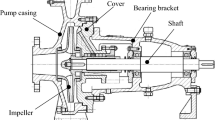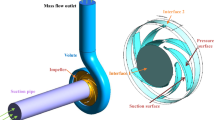Abstract
In this paper, the periodically unsteady pressure field and head-drop phenomenon caused by leading edge cavitation have been investigated numerically by computational fluid dynamics (CFD) in a single stage centrifugal pump. A CFD model for cavitation steady and unsteady simulation has been calculated using the k-ω SST turbulence model combining with a multiphase approach, based on a homogeneous model assumption. A truncated form of Rayleigh-Plesset equation is used as a source term for the inter-phase mass transfer. The CFD computational region includes the suction cone, impeller, side chambers and volute, as well as suction and pressure pipes. The results were compared with experimental data under non-cavitation and cavitation conditions and a good agreement was obtained for the global performance, the experimental data of the head and the efficiency are 34.04 m and 74.42% at BEP, respectively, the predicted head is 34.31 m and the predicted efficiency is 73.75%. The analysis of inner flow pattern shows that the vortex flow generation in the rear of cavity region is the main reason of the head-drop. Obvious increasing can be observed for the amplitude of the pressure fluctuation at the blade passing frequency with different cavitation situations, and subpeak can be found. Besides, the effects of unsteady flow in the side chambers cannot be neglected for accurately predicting the inner flow of the pump. These results imply that this numerical method is suitable for the cavitating flow in the pump.
Similar content being viewed by others
References
Pierrat D, Gros L, Pintrand G, et al. Experimental and numerical investigations of leading edge cavitation in a helico-centrifugal pump. In: The 12th International Symposium on Transport Phenomena and Dynamics of Rotating Machinery. Honolulu, 2008
Bouziad Y A. Physical modeling of leading edge cavitation: computational methodologies and application to hydraulic machinery. Ph.D. Thesis. Lausanne: LMH-EPFL, 2006
Ravi B, Eugene S, Simon B. Information of impeller leading edge profiles on cavitation and suction performance. In: Proceedings of the Twenty-Seventh International Pump Users Symposium. Houston, 2011
Fredrichs J, Kosna G. Rotating cavitation in a centrifugal pump impeller of low specific speed. J Fluids Eng-T ASME, 2002, 124(6): 356–362
Kimura T, Yoshida Y, Hashimoto T, et al. Numerical simulation for vortex structure in a turbopump inducer: close to relationship with appearance of cavitation instabilities. J Fluids Eng-T ASME, 2008, 130(5): 051104
Zwatr P J, Gerber A G, Belamri T. A two-phase model for predicting cavitation dynamics. In: Proceedings of ICME 2004 International Conference on Multiphase Flow. Yokohama, 2004
Tseng C C, Wei Y J, Wang G Y, et al. Modeling of turbulent, isothermal and cryogenic cavitation under attached conditions. Acta Mech Sin, 2010, 26(3): 325–353
Wu J Y. Filter-based modeling of unsteady turbulent cavitating flow computations, Ph.D. Thesis. Gainesville: University of Florida, 2005
Huang B, Wang G Y. Experimental and numerical investigation of unsteady cavitating flows through a 2D hydrofoil. Sci China Tech Sci, 2011, 54(7): 1801–1812
Coutier-Delgosha O, Fertes-Patella R, Reboud J L. Evaluation of the turbulence model influence on the numerical simulation of unsteady cavitation. J Fluids Eng-T ASME, 2003, 125(1): 38–45
Pei J, Yuan S Q, Yuan J P. Numerical analysis of periodic flow unsteadiness in a single-blade centrifugal pump. Sci China Tech Sci, 2013, 56(1): 212–221
Ji B, Luo X W, Peng X X, et al. Numerical analysis of cavitation evolution and exited pressure fluctuation around a propeller in non-uniform wake. Int J Multiphase Flow, 2012, 43: 13–21
Menter F R. Two-equation eddy-viscosity turbulence models for engineering applications. AIAA J, 1994, 32: 1598–1605
Mejri I, Bakir F, Rey R, et al. Comparison of computational results obtained from a homogeneous cavitation model with experimental investigations of three inducers. J Fluids Eng-T ASME, 2006, 128(11): 1308–1323
Singhal A K, Vaidya N, Lenoard A D. Multi-dimensional simulation of cavitation flow using a PDF model for phase change. In: ASME Fluids Engineering Division Summer Meeting. Vancouver, 1997
Li X J, Yuan S Q, Pan Z Y, et al. Effects of the near-wall mesh quality on the accuracy of numerical analysis in centrifugal pumps (in Chinese). Trans CSAE, 2012, 28(16): 67–72
Benigni H, Jaberg H, Yeung H, et al. Numerical simulation of low specific speed American petroleum institute pumps in part-load operation and comparison with test rig results. J Fluids Eng-T ASME, 2012, 134(2): 024501
Gonzalo-Flores N, Goncalves E, Fortes-Patella R, et al. Head drop of a spatial turbopump inducer. J Fluids Eng-T ASME, 2008, 130(11): 111301
Pouffary B, Fortes-Patella R, Reboud J L, et al. Numerical simulation of 3D cavitationg flows: analysis of cavitation head drop in turbomachinery. J Fluids Eng-T ASME, 2008, 130(6): 061301
Hirschi R, Dupont P, Avellan F, et al. Centrifugal pump performance drop due to leading edge cavitation: numerical predictions compared with model tests. J Fluids Eng-T ASME, 1998, 120(12): 705–711
Campous-Amezcua R, Kehelladi S, Bakir F, et al. Numerical analysis of unsteady cavitating flow in an axial inducer. Proc IMech E Part A: J Power Energy, 2010, 224(2): 223–238
Bachert R, Stoffel B, Dular M. Unsteady cavitation at the tongue of the volute of a centrifugal pump. J Fluids Eng-T ASME, 2010, 132(6): 061301
Author information
Authors and Affiliations
Corresponding author
Rights and permissions
About this article
Cite this article
Li, X., Yuan, S., Pan, Z. et al. Numerical simulation of leading edge cavitation within the whole flow passage of a centrifugal pump. Sci. China Technol. Sci. 56, 2156–2162 (2013). https://doi.org/10.1007/s11431-013-5311-5
Received:
Accepted:
Published:
Issue Date:
DOI: https://doi.org/10.1007/s11431-013-5311-5




